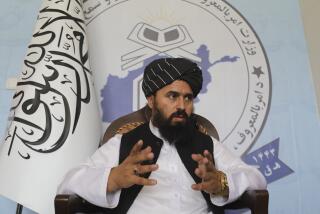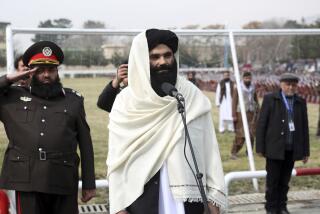Afghan anger over Koran burning an emblem of nation’s culture war
- Share via
Reporting from Kabul, Afghanistan — The spasm of violence that has shaken the country since copies of the Koran were dumped in a trash incinerator at a U.S. military base is emblematic of a culture war among Afghans themselves, one that is likely to grow more intense as the Western military presence wanes.
Five days of chaotic street battles have left more than 30 people dead, including two U.S. military officers killed Saturday in a heavily guarded Afghan government ministry. The unrest over the desecration of the Muslim holy book illustrated not only the depth of religious fervor felt by many here, but also a visceral distaste for Western behavior and values among a far broader swath of Afghan society.
At the same time, however, the Obama administration’s efforts to kindle negotiations with the Taliban have generated deep-seated fear among progressive Afghans of a theocracy-in-waiting that could come to fruition when most North Atlantic Treaty Organization troops depart.
Many worry that the United States and its military allies are so eager to find a way out of this war that they will give their blessing to an accord with the Taliban that does not adequately safeguard women’s rights or civil liberties.
“This is not just about relations with the U.S.,” researcher Martine van Bijlert wrote on the website of the Afghanistan Analysts Network in the first days of the Koran-burning protests. “This is part of a wider struggle over what kind of society Afghanistan is becoming, over who the custodians of religious power will be and what they will use it for.”
Kabul, the capital, and a few other big Afghan cities have a cosmopolitan veneer of shopping malls and smartphones and gel-spiked hairdos. But in a society steeped in conservative Islam, a decade of U.S. military engagement, coupled with a massive development drive that has brought thousands of foreign civilians to Afghanistan, has generated profound unease over outsiders’ behavior as a polluting influence.
The perceived insults are many: not only troops’ sometimes heavy-handed treatment of ordinary Afghans, or the video that surfaced last month of U.S. Marines urinating on the bodies of Taliban fighters, but also men and women consorting freely in heavily guarded international compounds, or the consumption of alcohol at restaurants with a mainly non-Afghan clientele.
Moreover, as the conflict’s endgame begins in earnest, some Afghans regard public expressions of piety as a way of hedging one’s bets. This month, for example, the Information Ministry ordered female television newscasters to cover their hair and refrain from wearing heavy makeup on-air, a directive that was widely ignored, but nonetheless cast a chill.
Those killed and injured in nearly a week of violent clashes, which broke out after U.S. personnel placed copies of the Koran in the “burn pit” at the giant Bagram air base north of the capital Monday night, have included demonstrators, bystanders and Afghan police officers. In addition, two U.S. troops were shot dead Thursday by an Afghan soldier apparently acting in solidarity with the protesters
Information on the killings of the two Americans on Saturday remained murky hours after the shooting. NATO’s International Security Assistance Force confirmed the deaths of two of its service members in Kabul, without disclosing their nationalities, although Afghan officials speaking on condition of anonymity identified the two as U.S. military officers who were advising the Interior Ministry.
A ministry spokesman, Sediq Siddiqi, said the officers’ bodies had been discovered in a command-and-control center used by foreign advisors, and that the assailant had apparently escaped. U.S. Marine Corps Gen. John R. Allen, the commander of Western troops in Afghanistan, vowed to “pursue all leads” to find the killer.
“The perpetrator of this attack is a coward whose actions will not go unanswered,” he said in a statement.
By week’s end, the Koran-burning riots had turned into one of the most sustained outbreaks of civil unrest in Afghanistan since the start of the war, despite an early and emphatic apology by Allen. Further expressions of regret, in the form of a letter from President Obama delivered Thursday, also did little to quell public passions, though he was pilloried for the apology by Republican rivals at home.
For some Afghans, particularly the better educated, the scenes of strife triggered conflicting emotions. Many believed that the protests were being deliberately exploited by a variety of players: the Taliban movement, neighboring countries — such as Iran and Pakistan — that generally rejoice at yet another American misstep, and various domestic political factions.
Still, the sense of bone-deep grievance, expressed in furious cries of “Death to America!” that echoed at the scene of virtually every protest, resonated even among those who would never consider taking to the streets with sticks and stones in a rallying cry for Islam.
“I was personally offended by what happened,” said Hamed Saboori, a college-educated 30-year-old who described himself as a moderate Muslim. “But there are elements that want to take advantage of this irresponsible act. The whole issue has been manipulated.”
Some imams, or mosque preachers, delivered fiery sermons that helped drive the protests, turning the week’s events into a broader complaint about the Western entanglement in Afghanistan.
“Burning the Koran at Bagram is an unforgivable crime and sin,” Inayatullah Baleegh thundered from the pulpit of a Kabul mosque Friday, the main prayer day of the Islamic week. “But the presence of infidels in a Muslim country is an even bigger sin.”
The Taliban, too, sought to portray a society that had fallen in thrall to the West.
“Under the slogan of ‘freedom,’ new doors of corruption are being flung open every day,” the movement said in a midweek statement, as the protests were gathering force. “Blind imitation of the Western infidels is being encouraged in our cities and villages; the veil of modesty and dignity is being lifted from our women under the slogan of ‘women’s rights.’ ... All these things are brought to us by the accursed Western invasion, which is forcing itself upon us in the name of democracy.”
Insurgents have previously used violent protests as cover for attacks on government buildings and NATO bases, both of which were targeted repeatedly over a period of days. As the days passed, more gunmen were spotted in the crowds, and some protesters waved the white flag of the Taliban.
Afghan President Hamid Karzai, accustomed to walking a fine line between his American patrons and popular sentiment, called for calm, but tempered that with expressions of sympathy for the protesters’ cause, urging police to exercise restraint and patience with “emotional” demonstrators.
Even if the protests show signs of ebbing, lasting damage may have been done to what the Americans regard as essential partnerships with the Afghan government and security forces.
After Saturday’s shooting deaths of the two Americans at the Interior Ministry, Allen recalled all Western military personnel working in ministries “for obvious force-protection reasons,” a serious blow after years of American efforts to make the ministries more efficient and less corrupt. And the general himself traveled Thursday to the base in Nangarhar province where the two American troops were shot and killed by a member of the Afghan army, urging his troops to stifle any impulse to take revenge.
“Everything that happened this week makes it harder for anyone to trust anyone,” said Zeinab Khuttab, a university student in Kabul. “And that was probably the intention behind it all, to drive everyone further apart.”
Special correspondent Hashmat Baktash contributed to this report.
More to Read
Sign up for Essential California
The most important California stories and recommendations in your inbox every morning.
You may occasionally receive promotional content from the Los Angeles Times.










